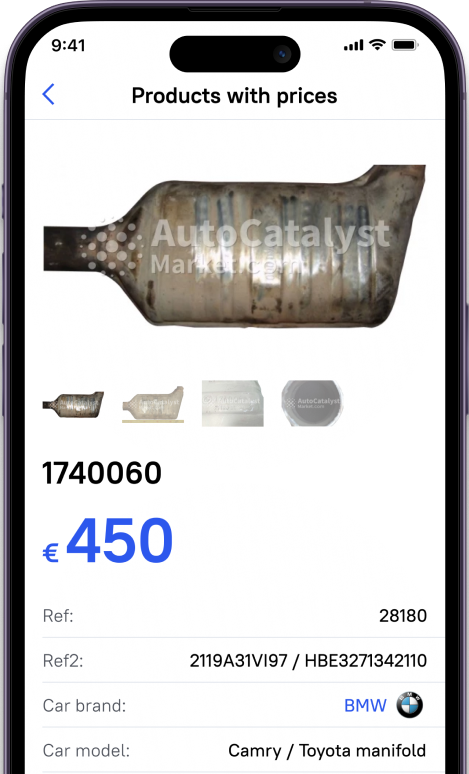- Troubleshooting Catalytic Converter Issues
- Why do catalytic converters get bad?
- Remember about things that cause problems with the catalyst:
- Absence of bad catalyst symptoms will provide:
Troubleshooting Catalytic Converter Issues
Catalytic converters are important parts of the exhaust system. Catalysts have two functions: to purify exhaust gases before being emitted into the atmosphere and to reduce additional resistance. The catalytic converter is located on the underbody of a vehicle between the muffler and exhaust manifold. Catalyst is installed on both gasoline and diesel engines. That means a catalytic converter is used for each type of transport with internal combustion. Drivers must control the work of the catalytic converter since motor power depends on it. Bad catalyst leads to increased fuel consumption and lower vehicle dynamics. The damaged and old catalytic converter has to be professionally recycled by specialized companies
What are the symptoms of a bad catalytic converter? At first symptoms, accurate catalyst check can be done independently or in the care service. Drivers, even with little experience, will be able to easily determine if there is a malfunction in the exhaust system, which is most often associated with the catalytic converter.
-
If exhaust gas began to pass poorly into the tube, this will affect the “behavior” of the auto. It will hardly gain speed due to problems with the catalytic converter. In this case, the problem is felt up to a certain point, which depends on the degree of contamination of the catalyst.
-
When accelerating along a suburban highway, transport will slowly increase speed in low gears, and when shifting to higher, it will start working as usual. A good reason to check catalytic converter.
-
There may be a feeling that there is a heavy load in the back of a car (catalyst location), which is why acceleration is slow. This is the catalyst that tries to show drivers important signs.
-
Check Engine light is on. If a catalytic converter is bad, some electronic control units light a lamp with a request to check so that the driver understands that there is a malfunction.
-
An error message P0420 may light upon the onboard computer(typical catalytic converter sign) when the catalyst goes bad. A problem with the efficiency of the motor.
-
Increased fuel consumption, caused by the catalyst. A bad catalytic converter may increase fuel consumption. Please note that an increase in consumption indicates a malfunction in the exhaust system only if there is a problem with slow speed gain. If the catalyst is badly damaged or clogged, the car may not start. Or the motor will start, but stall after a few seconds of operation.
Why do catalytic converters get bad?
If there are problems with a catalyst, it is covered with dirt or deformed. Most often, the following reasons lead to failure of the catalytic converter and urgent need to get rid of the old catalyst.
Remember about things that cause problems with the catalyst:
-
Low-quality fuel. If the fuel-air mixture does not have time to completely burn out in the combustion chamber, it burns out in the manifold or catalyst. This leads to the fusion of elements of the exhaust system. As result combustion products get stuck in the catalytic converter, thereby preventing air from passing at the required speed;
-
Bad catalytic converter. If a non-original catalyst is used, then there is a great risk of acquiring a model where cells have a small diameter, because they quickly clog by combustion products. Such a problem can be observed with catalysts in cars designed for the American market, where fuel quality is higher and fewer combustion products are left from it. Catalytic converters with small “cells” are installed in such vehicles.
-
Problems in motor. It leads to an increase in products of combustion in the exhaust. In this case, only professional diagnostics of the catalytic converter is needed. Because a clogged catalytic converter is often a symptom of a malfunction.
-
Driving bad roads. With regular driving on bad roads, catalytic converters can get mechanical damage. The impact will lead to the destruction of catalysts' honeycombs or their deformation. Also, such a problem can be observed after an unsuccessful attempt to overcome an obstacle.
-
Engine overheating. Many drivers, especially in summer, allow driving overheated. During motor overheating, exhaust gases reach extreme temperatures, as a result very high-temperature flow through the catalyst. Melting and destruction of honeycombs of a catalytic converter is guaranteed.
-
Increased oil consumption. Drivers who allow increased oil consumption destroy the catalyst. Due to increased oil consumption, catalyst cells are coated with a thick layer of soot. Under the influence of high temperatures, soot starts burning and the honeycomb of a catalytic converter melts.
-
Faulty lambda sensor causes malfunction of the control unit.
Problems with catalytic converters can lead to the failure of expensive components. It is recommended to eliminate the problem as soon as possible after having a previously diagnosed catalytic converter. Choose a way to evaluate old catalyst and sell It to obtain a good money bonus.
Absence of bad catalyst symptoms will provide:
-
Increased service life of gasoline and diesel vehicles, thanks to healthy catalyst.
-
Extension of resource and normal operation of motors.
-
Exclusion of dry start motors with the help of a good catalytic converter.
-
Reduction of CO, CH, smoke, vibration, inner noise.
-
Increased power and efficiency with clean catalyst.
-
Magnitude of octane number of gasoline by 3-5 units.
-
Cleaning of soot from candles in presence of defects.
-
Improved launch in winter, owing to hardworking catalytic converter.






































